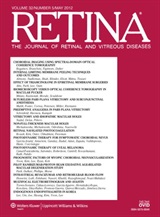La neovascolarizzazione maculare si può sviluppare negli occhi affetti da maculopatia degenerativa, non per le alterazioni senili tipiche dell’anziano, ma per la fragilità dei tessuti maculari legata alla miopia. Negli ultimi anni questa condizione, in passato molto distruttiva, ha trovato grande giovamento nella terapia iniettiva con inibitori del VEGF (Lucentis o Avastin).
Questo studio effettuato su 40 pazienti consecutivi cerca di identificare quale siano gli elementi anatomici e patologici legati ad un maggior successo visivo delle terapie effettuate.
Viene confermata la buona efficacia della terapia iniettiva in questa condizione. In particolare, come la pratica clinica aveva già indicato, il numero di iniezioni necessarie a controllare la malattia è molto ridotto rispetto alla maculopatia senile: nello studio in media 2,8 iniezioni in 12 mesi. Nel 55% dei pazienti si è ottenuta la completa scomparsa della lesione neovascolare.
Tra i fattori prognostici, quelli risultati significativamente legati alla quantità di visus residuo (in senso peggiorativo) sono risultati essere la presenza di atrofia peripapillare e la presenza di lacquer crack nella zona foveale.
Yoon, Jong UK MD*; Kim, Yong Min MD*; Lee, Sung Jun MD†; Byun, Yeo Jue MD*; Koh, Hyoung Jun MD*
Retina
May 2012 – Volume 32 – Issue 5 – p 949–955
Methods: Forty eyes of 40 consecutive patients with myopic CNV who had received intravitreal ranibizumab or bevacizumab injections were retrospectively reviewed. Baseline visual acuity, presence of lacquer crack, dark rim, peripapillary choroidal atrophy size, and location of myopic CNV were evaluated using fluorescein angiography and indocyanine green angiography.
Results: The logarithm of the minimum angle of resolution best-corrected visual acuity (BCVA) at 12 months after treatment was 0.23 ± 0.28, and there was a significant improvement compared with the baseline BCVA (P = 0.001). After multiple linear regression analysis, baseline BCVA, presence of lacquer crack extending the fovea, and peripapillary choroidal atrophy size were the factors that significantly correlated with BCVA at 12 months (P = 0.001, P = 0.04, and P = 0.04). For mean change in BCVA over 12 months, there were also significant correlations with baseline BCVA, lacquer crack extension to the fovea, and peripapillary choroidal atrophy size (P = 0.001, P = 0.03, and P = 0.03). The mean number of anti–vascular endothelial growth factor injections was 2.8 ± 2.0 over 12 months. Complete resolution of myopic CNV was noted in 22 eyes (55.0%) after initial first injection, and no additional treatment was required in 12 eyes (30%).
Conclusion: Better baseline BCVA, lacquer crack extension to the fovea, and peripapillary atrophy were negative prognostic factors of visual acuity improvement, and there was quite a promising result of anti–vascular endothelial growth factor treatment in patients with myopic CNV.

